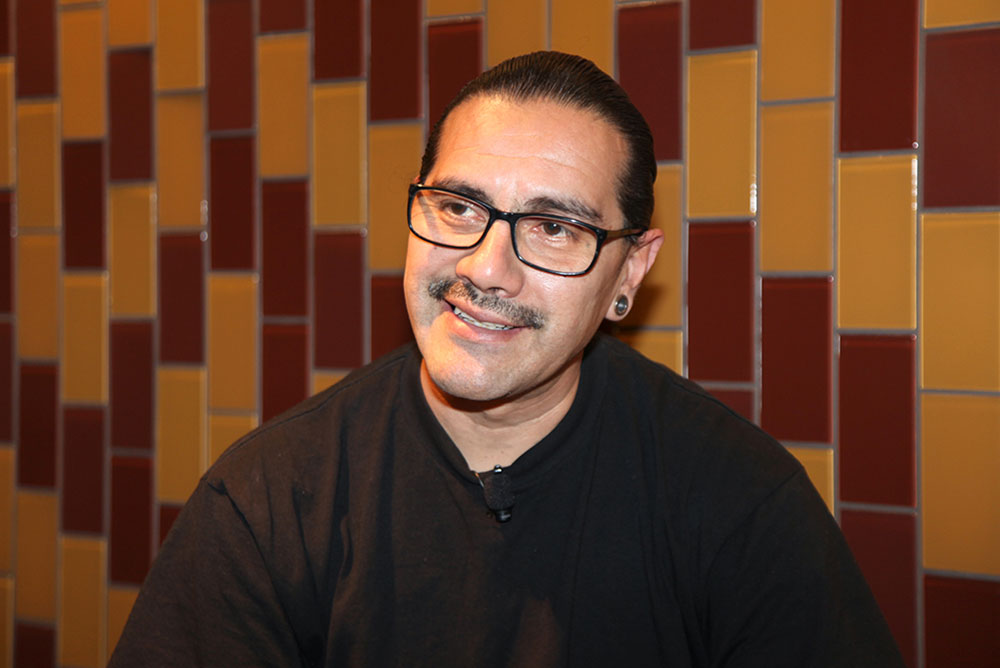
Image by Aaron Salcido.
Fabian Debora is a Chicano artist based out of Boyle Heights and the co-founder and executive director of Homeboy Art Academy. Before speaking at the Zócalo event “How Do We Begin Again?,” held at the ASU California Center at the Herald Examiner in downtown L.A., he spoke in the green room about his best advice for emerging artists, how he found his own voice, and why it took going to Rome to become friends with L.A. author Luis Rodriguez.
What’s your favorite thing to get on the menu at Homegirl Café?
I always go for the carnitas tacos with the apple slices. That’s the best. Or the chilaquiles.
Where’s your favorite place to go in LA?
I’m about the people—I’m with the people, for the people—so I think I would say any event that is happening in Mariachi Plaza that has to do with the betterment of our community, or a community artist exhibit.
Who’s the last artist that surprised you?
There’s this rapper named Mescalito from Boyle Heights. I’ve known him since he was a youth. Every year, he surprises me with new and improved stuff [while staying] true to the roots of Boyle Heights. I’m old school from the ’80s, and he holds that essence with a modern twist.
What’s your favorite book?
It would have to be Always Running by Luis Rodriguez. That book held me through juvenile hall, and it also held me through adult incarceration. I don’t know how many times I read that book. It’s a book of inspiration, hope, and it was familiar [because] I had hopes, dreams, and aspirations as an artist; and Luis Rodriguez was a writer, and he was formerly gang-involved, formerly incarcerated. That book helped me in that it kept opening that window and reminding me that regardless of the circumstances, the situation, you could still accomplish this. Luis Rodriguez and I are good friends. Now to be in the place I am, it just trips me out—like fool, you don’t even know how much your book has helped me on many levels ways.
How did you and Luis become friends?
I’d heard of him, and I read the book, but it wasn’t until we went to Rome, Italy, [in 1994 while I was doing a graffiti art convention] that I met him. Isn’t that crazy? I mean, we’re neighbors, practically [in Los Angeles], and we’re meeting out here in Rome.
You are a mentor to many artists today. What’s the best advice you have for them?
The best way that I have been able to hold and build relationships amongst young artists who are trying to find their way is just by allowing that freedom of expression to exist within the space by giving minimal input and allowing them to embody their story. That is what makes an artist. If you’re really trying to convey a message, then what is that story? We are all unique.
How did you come to realize that in your own work?
I remember when I first got clean and sober and I got out of prison and I was trying to find my way via the arts, I was too busy looking at other people’s work and I got consumed by institution art—I want to be in MOMA, I want to be in LACMA. I was looking too much, trying to mimic other people’s work, when I really had it in me all this time. And so I stopped being driven by the institutions—I don’t want to be in LACMA anymore, I don’t want to be in MOMA anymore! I created my own institution, and that is always stemming from the community. Not to say I’m not in LACMA, not to say I didn’t reach those goals, but that is not the driver any longer. But it wasn’t until I met Vincent Valdez and David Botello, they are pioneering Chicano artists. They took me in at 17. Later, Vincent Valdez gave me an internship, and he’s the one who really helped fine tune my work and gave me the idea because he said: “you have the composition, you have the technical expertise, but what you have that I don’t have is the story, bro.”
What’s the story that you find yourself still trying to tell in your art?
Once you start to evolve as an artist or as an individual, recognizing the systemic infrastructures of exclusion and inequities, you start to realize that most of the decisions and circumstances were already in place for you. Both my parents are immigrants, so the obstacles were already there, and then living in the housing projects in Aliso Village of Boyle Heights in the ’80s. Damn, look at those chances, right? At one point, you begin to blame yourself and you start to build resentments around your family and all that. Personally, when I create art, it’s always to make sure that they serve as portals, as windows, so that it’s reflective of my community. I paint for those in my community, for the voiceless. My responsibility as an artist is to remove all stereotypes to identity, culture, religion, and gender. As a former gang member, as a Mexican American, I have been oppressed, and I have also been excluded at many levels. So what I want to do within the art is to shine light on the beauty that comes from within my community, such as Boyle Heights, and most importantly, the core values that come from my people.
Last question: Who’s the person in the world you’d most like to meet?
Maria Rosario Jackson, [the new head of the] National Endowment for the Arts. She’s Blaxican—African American and Mexican. I just did two beautiful large-scale murals in South L.A. of a Black woman and a Mexican woman. I want to hand her two prints of [the women] as a gift and then get a dialogue going with her about the work we’re doing with gang members.



